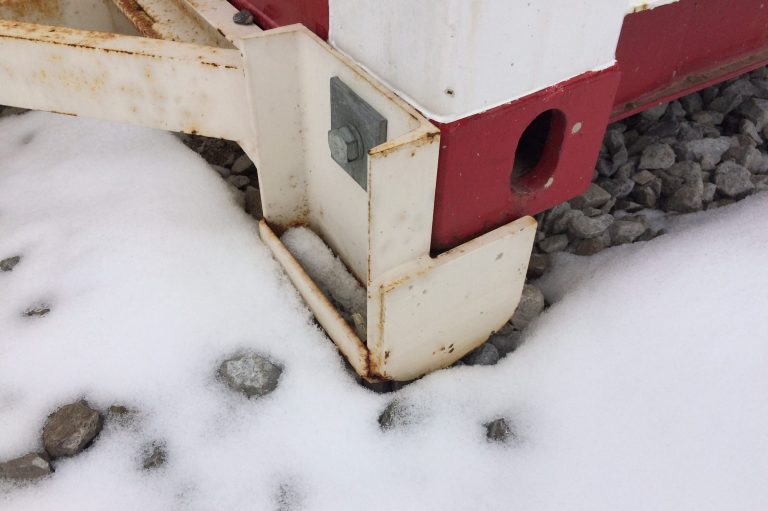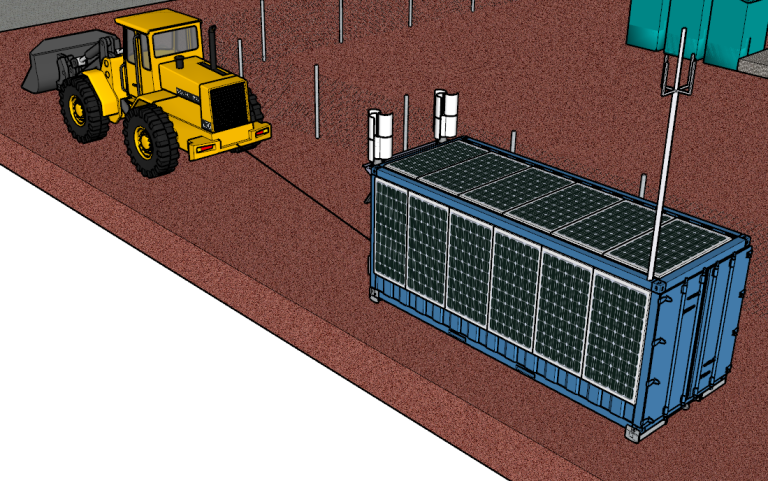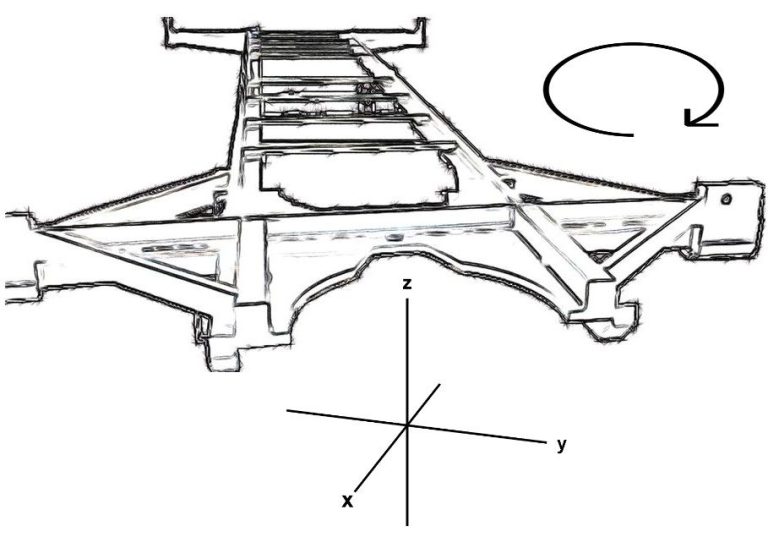böks sled
Field tested for years in the worst of conditions our boks sea container sled is a device developed to be mounted under sea containers to the CSC/ISO mount point on the corner blocks of any sea container. It operates as a sled/sleigh carrying empty or fully loaded sea containers in a drag, lift, slide function. The Sea Container sled ensures that the following aspects of moving and handling sea containers are addressed.
Primary Advantages
- Lower operational costs by using a roll-off truck for multiple duties outside of just hauling waste.
- Lower risk and liability by having the right application for the job. (no staircases, no continuous mechanical setup, easy to shore up and manage)
- Reduce damage to the superstructure of the ISO sea container; thus extending the equipment life.2x,3x...
- Increase the functionality and utility of existing or new container fleet
- Allow any machine to handle container mobilization to the point of work.
- Lower time lost in operational inefficiency on the job site - ie. Location of breakrooms, tools, materials, union employee requirements etc.
- Ability to move loaded container across any terrain. (Slide - SLED)
- A single roll-off truck operator can mobilize and demobilize.
- All ISO Sea Container mechanical structure is still accessible and useable. (ie. side and front\back doors)
- All standard ISO mechanical fixtures and binding hardware can still be used.
- The sled does not need to be removed for highrise construction. (but can be easily)
- Allow Sea Containers and Sled combination to be mobilized in hard to access areas.
- Not over dimensional and containers can still be joined to make large area.
- Reduce operating costs on high density and limited access sites where unloading and loading access is limited.
- Increased revenues through use of your roll-off fleet.
- Process and project management complexity significantly reduced. (i.e. use the same application for waste handling, materials handling and all secured)
- Make use of tilt'n load trailers as well using the sled.
- Full functionality from front and back. (loading, moving)

the böks sled will:
- Ensure air flow around Sea Containers
- Allow for easy movement of Sea Containers across any terrain using common site equipment.
- Allow for the Sea Container Super Structure to stay intact while its in service.
- Raise Sea Containers off the ground.

- Support the entire structural frame of the Sea Container
- Allow for easy loading and unloading of the Sea Container and Sea Can Sled as one unit on multiple tractor types by a single operator.
- Extend the life of a Sea Container greatly.
- Address all safety requirements in the use of Sea Container in the field.

- Be continually adaptable to Sea Container requirements as people think of more uses for them in the field.
- Add significant rigidity and structural enhancement to Sea Containers.
- Meet core design requirements by balancing lightweight and ultra strong design for all infield applications.

- Allow the Sea Container Sled mounted with Sea Container to be dead lifted vertically.
- Allow for the Sea Container Sled mounted with a Sea Container to traverse slopes and inclines using standard machinery.
- Allow for the removal and deployment of the Sea Can Sled with a mounted Sea Container to be deployed in any location.
- Meet all heavy transportation requirements of goods and machinery by creating the sled to meet ISO/CSC requirements.

the böks sled design:
Extend the life of the SeaCan greatly; especially if moved often over any terrain without destroying structural integrity.

Deploy our revolutionary sleds which have been adjusted to meet the unique demands of industrial roll-off trucking applications. Furthermore, we've made significant enhancements to SeaCan technology, such as introducing solar energy systems, perfecting a 20' length deployment, and addressing challenges associated with extreme terrain, constant movement with work crews and extreme winter in-field applications.

Address needs with our sled application, we enable crews to have their work office or workshop with materials and machinery within feet of their work location, facilitating easy and efficient relocation of the work site across varied terrains. We are confident that the high build standards in our Sea Container Sled application exceeds all job requirements.

Address the primary design using no moving mechanical parts once affixed to the Sea Container.

Create a sled design which allows us to load SeaCans frontwards and backwards; we can also pull the SeaCans from the corners when locked in an urban construction or dense remote environment; loaded without heavy machinery ie. Heavy lift forklift, crane or front-end loader on site using only one truck operator.

Address needs over the past five years, our Sea Container Sled and SeaCanSolar power system offerings have demonstrated their ability to comply with and overcome industry regulations, offering a competitive edge in many industries and we see the opportunity for the Sea Can Sled to be used worldwide.

Address the operational risks and insurance claims associated with trailers and staircases in field has also been dramatically reduced by introducing the Sea Container Sled beneath the Sea Container and easily allowing entry and exit of a Sea Container on any terrain and condition.

the böks sled story
Through many years of experience (began as SeaCanSolar) in the field we noticed that there were many issues to address around the logistics of handling SeaCans (sea containers). We noticed that the SeaCans cannot easily move (forward, backward, pivot) SeaCan around a jobsite to the point of work; and when operators attempt to move these SeaCans they often get damaged often in transport (especially fully loaded), get ruined sitting on the ground or moved around without a sled underneath where air and moisture is not free to flow around the structure of the SeaCan.
We often found the SeaCans were prone to animal infestation, mold and insects making homes beneath the SeaCans and in the core structure (ribs/cross members and frame)
During moves we often found the bottom ribs/cross members and floorboards rot/corrode rapidly from all the moisture and/or environmental conditions i.e. soft wet soils, manure and farm applications, frozen/thawing ground etc. In that we found the super structure and upper body of the SeaCan tend to corrode and fall apart quickly without moving air flow around the SeaCan unit/s. we have also addressed issues during moves where the core frame of the SeaCan becomes softened and dangerous to lift and move over time; thus ending up unloading all goods inside the SeaCan and an on the spot crushing, removing, recycling of the SeaCan which is costly.
Having been on many large sites moving containers requires costly special equipment particularly when loaded (ie. heavy duty forklift, crane, flatbed/tilt'n load)

Logistical issues when we found SeaCans without a sled beneath are often locked into tight spaces and cannot be moved or loaded. We then normally must convene a crane or a heavy lift forklift.
We found that built out SeaCans sustain significant damage and/or lose parts of the assembly - i.e. propane for hvac, tooling for specialty applications, gensets etc.
For those sites that did not understand how the SeaCans are constructed we found that the super structure on the SeaCans often becomes twisted and the superstructure offset due to corner or front/back side dragging without a Sea Container Sled. Hinges, locking bars, guides, and brackets, fitted doors/windows often stop functioning because of the ISO SeaCan frame being bent because it was not handled with proper equipment.

We have had to bring in equipment particularly in support of SeaCans as they cannot be dragged or moved easily over harsh environments – quarries, mines, forests, farms, frozen bodies of water etc. We found that project managers and planners never consider the removal of the equipment when the job is done and is usually a cost they do not anticipate.

We sat back and watched the number of operational deficiencies and huge costs associated to a few SeaCans can amount to as they cannot be mobilized and demobilized using limited resources over short and long distances.
We thought we can address a lot of the issues from a well-built piece of apparatus that would address all the issues noted.

From a tactical point of view, we knew we had to find a method to support mobilisation and demobilisation that can handle the gross weight of a fully loaded container. We had to be able to move a SeaCan with the work crews along all job sites and all surfaces. (Large and small rock, sand, soil, ice and man-made surfaces – asphalt, concrete etc.) Also be able to be moved around easily under all dimensional clearances in remote and urban conditions.

Where one of our clients were traditionally using rolling trailers which inevitably get destroyed by the end of the operation.

Need to meet all regulations to be lifted and used in high-rise construction, pipeline and rail and highway construction, mining applications and large agricultural operations; essentially, we must design for the conditional extremes. Therefore, addressing x, y and z axis movement.
We need to be able to move SeaCan across all terrain (broken or flat asphalt/concrete, rock, soil, sand) easily with almost any machinery on site. (using limited resources and maintain operational efficiency). We found both a front-end loader and backhoe being the most common of applications.

We found that the superstructure needs to be supported and to easily be able to level the containers out onsite or build a system that self levels.

We also want to use standard CSC/ISO SeaCan equipment (ie. joiners and clasps) as it exist in abundance in the shipping and transport industries.
Finally, we determined that the SeaCan had to be able to be picked with a roll off truck, J Hook Lift truck or a flat bed/tilt and load in tight quarters from the front and back without destroying any equipment with one operator. Also be able to pull the SeaCan's from the corners; on a diagonal without causing any structural damage to the SeaCan. We chose the roll off truck adaptation as the primary focus as it is the most common, most rugged, and versatile tractor truck worldwide as they are most often used for waste disposal and are built heavier than most tractor trucks.

We took the idea to cad and to the shop and deployed prototypes in the field.
The rest is history the boks sled has spoken for itself and all the infield operators love using it as it saves them time, money and has addressed safety and risk concerns as well.

We need your consent to load the translations
We use a third-party service to translate the website content that may collect data about your activity. Please review the details in the privacy policy and accept the service to view the translations.
